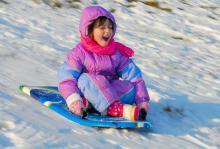
Sledding is a popular winter activity for the whole family. Since sleds are relatively inexpensive and snow-covered sledding hills are free, sledding provides a great opportunity for children to enjoy the outdoors and nature while offering good physical exercise and fun.
The earliest uses of sleds were for transportation and survival. The original snow sleds were also known as toboggans and many tribes in North America used them for transporting heavy loads great distances. The toboggans were made from two or three thin hardwood boards that were curved around at the front by using heat. Wooden crossbars were attached to hold the boards together and a rope was attached at the front for pulling by man or dogs. Around 1800, fur traders built up the wooden toboggan with enclosed sides and back, and a partially covered top for carrying people as well as their hides.1
The credit for recreational sledding has been given to some British tourists visiting St. Moritz, Switzerland in the early 1870s. Seeing wooden delivery sleds being pulled by young boys for odd jobs, they discovered that when they sat on them and were pushed down a hill, they were great entertainment. With the help of Swiss craftsmen, they devised ways of improving the steering capabilities of these sleds, and soon sledding became a popular winter pastime.2
In 1889, Samuel Leeds Allen patented the first flexible-runner sled that allowed a sled to be steered by hand. His Flexible Flyer was manufactured by the S.L. Allen Company of Philadelphia and featured a pair of steel runners that could flex to aid steering.3 His improvements on others’ earlier designs allowed for steering with little effort by using a floating crossbar between the runners. The Flexible Flyer became a huge success and has been produced for over 100 years.4
Today’s sleds can be made of wood, such as the Flexible Flyer, as well as of plastic or foam. The plastic and foam sleds are light in weight and inexpensive and are comparable in speed and control. Wooden sleds with metal runners offer the best control, but they are heavier to carry.5
Saucer sleds are circular discs that have a concave shape that allows a child to sit cross-legged in the center. They are made of a lightweight material, are easy to transport, and are inexpensive. These qualities make them very popular, and because they do not allow for any steering, they provide a fast and wild ride.6
Toboggans are still enjoyed on sledding hills today. The flat bottom of the traditional toboggan sits directly on the snow and can accommodate a single rider or a group of children. The front rider attempts to control the direction of the toboggan by using a foot to drag in the snow on either side, and stopping requires using both feet by digging the heels into the snow.7 Toboggans can also be equipped with runners and a steering wheel to aid in greater control.8
The speed of all sleds is affected by several factors. Gravity plays a major role in the movement of the sled, and the steepness of the hill’s slope along with the body maneuvers of the rider affect the ride. The design and materials of the sled play an important part, and the weight of the sled as well as the weight of the rider also affects the speed. The more riders on a sled produce more weight, which results in faster speeds.9
The best hills for sledding are not too steep, have a long flat area at the bottom to allow a comfortable distance to stop, and are free of obstacles. Sledding is potentially dangerous. Head injury is the biggest risk as well as other injuries that can occur from sledding into obstacles, such as rocks or trees, or by being thrown off the sled while going fast downhill. Icy conditions make controlling sleds more difficult and also make for harder landings if a child falls off a sled. Cold temperatures can also result in frostbite or hypothermia if children get too wet while sledding.10
- 1. “History of Sleds and Toboggans.” Sleds.com. < http://www.sleds.com/snow-sleds/historyofsledsandtoboggansarticle.cfm > 15 Dec. 2011.
- 2. “Tobogganing and Sledding – A History and Comparison.” The SnowSkiing Channel. < http://www.snowskiing.com/blog/tobogganing-and-sledding-a-history-and-comparison/ > 15 Dec. 2011.
- 3. Kram, Mark. “A Gift For A child With Everything: Rosebud For A Budding Citizen Kane.” Sports Illustrated Vault. < http://sportsillustrated.cnn.com/vault/article/magazine/MAG1089310/index.htm > 15 Dec. 2011.
- 4. “Vintage Flexible Flyer Snow Sled.” Vintage Winter. < http://www.vintagewinter.com/products/vintage-flexible-flyer-snow-sled > 15 Dec. 2011.
- 5. “Types of Sleds.” Sleds.com. < http://www.sleds.com/snow-sleds/typesofsledsarticle.cfm > 15 Dec. 2011.
- 6. Li, Piper. “Winter Sleds For Kids.” Livestrong.com. < http://www.livestrong.com/article/360128-winter-sleds-for-kids/ > 15 Dec. 2011.
- 7. “Sledges and Toboggans.” Active Outdoors. < http://www.activeoutdoors.info/activeoutdoors/Article111.html > 15 Dec. 2011.
- 8. Op. cit., “Types of Sleds.”
- 9. Dakota, Milo. “Snow Sleds Weight VS. Speed.” Livestrong.com. < http://www.livestrong.com/article/374711-snow-sleds-weight-vs-speed/ 15 Dec. 2011.
- 10. “Safety Tips: Sledding.” KidsHealth. < http://kidshealth.org/parent/firstaid_safe/outdoor/safety_sledding.html > 13 Dec. 2011.

